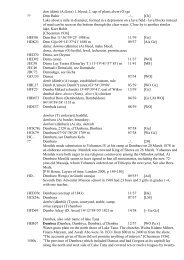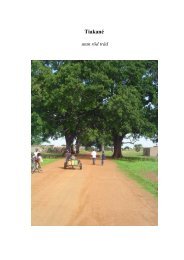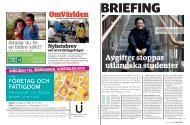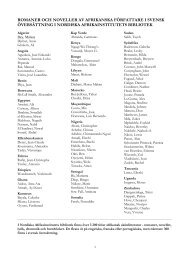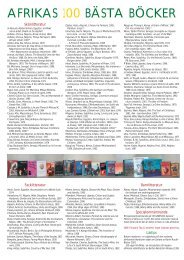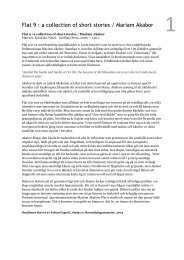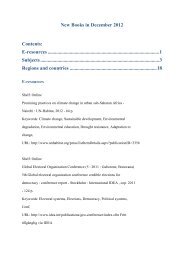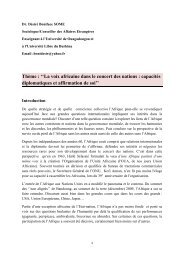Daniel Mekonnen - Full paper - Nordic Africa Institute
Daniel Mekonnen - Full paper - Nordic Africa Institute
Daniel Mekonnen - Full paper - Nordic Africa Institute
Create successful ePaper yourself
Turn your PDF publications into a flip-book with our unique Google optimized e-Paper software.
Pre- and Post-Migration Patterns of Victimization among Eritrean<br />
Refugees in the Netherlands<br />
Table of Contents<br />
Abstract ................................................................................................................................. 1<br />
1. Introduction .................................................................................................................... 1<br />
2. Narratives of victimisation by Eritrean refugees .............................................................. 3<br />
2.1. Primary victimisation ................................................................................................... 6<br />
2.2. Secondary victimisation .............................................................................................. 9<br />
2.3. Tertiary victimisation ..................................................................................................14<br />
3. Conclusion ....................................................................................................................18
Pre- and Post-Migration Patterns of Victimisation among Eritrean<br />
Refugees in the Netherlands<br />
<strong>Daniel</strong> R <strong>Mekonnen</strong> �<br />
“If there is any place called hell in the world, it should be in Libya.”<br />
An Eritrean refugee recounting his experience of the journey in the Sahara Desert, a place<br />
where secondary victimisation occurs most frequently.<br />
Abstract<br />
Forced migration is one of the major indicators of human insecurity. Throughout its history,<br />
Eritrea has seen a recurring cycle of mass political violence and contagious regional armed<br />
conflicts. As a result, Eritrea is one of the leading refugee-producing countries in the world.<br />
After independence in 1991 Eritrea has seen a major decline in the mass exodus of its<br />
population. The trend has completely changed in the aftermath of the 1998–2000 Eritrea-<br />
Ethiopia border conflict and particularly after 2001 when Eritrea became one of the most<br />
repressive regimes in the world. By examining forced migration as one of the major indicators<br />
of human insecurity, this <strong>paper</strong> discusses pre- and post-migration patterns of victimisation<br />
among Eritrean refugees in the Netherlands and in so doing the <strong>paper</strong> analyses the challenge<br />
from a victimological and human security perspective. The study is based on narratives of<br />
victimisation told by Eritrean refugees in the Netherlands. The data, obtained between April<br />
and October 2010, is gathered by open-ended narrative interviews with a number of Eritrean<br />
refugees in the Netherlands, a majority of whom have arrived in the country after 2002.<br />
Key terms: forced migration, victimisation, victimology, human security, human rights,<br />
trauma<br />
1. Introduction<br />
Eritrean history is marked by a recurring cycle of political violence and contagious regional<br />
armed conflicts. This has made the country one of the major spots of mass victimisation.<br />
Eritrea is also one of the leading refugee producing countries in the world. The trend was<br />
halted for a brief moment after the country‟s independence in 1991. However, with the advent<br />
of a full-fledged authoritarianism in 2001, which is preceded by the 1998–2000 border<br />
�<br />
Dip Law (Asmara), LLB (Asmara), LLM (Stellenbosch), LLD (Free State); Bank of Ireland Fellow at the Irish<br />
Centre for Human Rights, NUI Galway; formerly Judge of the Zoba Maekel Provincial Court, Eritrea; email:<br />
danielrezene@gmail.com. The author is indebted to the interviewees who were willing to share their<br />
experiences. The financial and institutional support of the Netherlands Organisation for Scientific Research<br />
(NWO) and INTERVICT at Tilburg University, respectively, is duly acknowledged. Errors are attributable only<br />
to the author.<br />
1
conflict with Ethiopia, forced migration has again become one of the distinctive trademarks of<br />
Eritrea. Given this sad reality, the designation of the Eritrean population by Gaim Kibreab as<br />
a society severely inflicted by a “powerful obsession to migrate” 1 should come as no surprise.<br />
This is further epitomised by the metaphoric observation of Nathaniel Meyers who travelled<br />
to Eritrea in mid-2010 and observed that Prison Break 2 was the television series most<br />
Eritreans wanted to watch. 3 Beneath this penetrating metaphor is the tragedy of Eritrea<br />
becoming an open giant prison where every member of the population consider themselves<br />
prisoners and relatives outside of the country are deemed rescuers. Similarly, Tania Müller<br />
also notes that as a result of the unbearable situation in the country, Eritrea‟s brightest minds<br />
“spend their mind devising strategies how to best leave the country.” 4 In a broader <strong>Africa</strong>n<br />
context, this resonates with the observation of Yash Tandon, who holds, “The most shocking<br />
aspect of <strong>Africa</strong> today is the exodus of its people.” 5 This reality is harsher in Eritrea than in<br />
many other <strong>Africa</strong>n countries.<br />
In 2008, Eritrea was the second highest refugee-producing country in the world in absolute<br />
numbers. 6 Despite its small population size, the figures are exceedingly fear-provoking. On<br />
the other hand, the Netherlands is one of the major recipients of refugees in Europe. In 2009,<br />
nearly 15 000 new asylum applications were filed in the Netherlands. 7 These include a<br />
considerable number of applications by newly arriving Eritrean asylum seekers. 8 According to<br />
experts, the 2009 statistics portray an increase of eleven per cent in the total number of<br />
1 Gaim Kibreab “The Eritrean Diaspora, the War of Independence, Post-Conflict (Re)-construction and<br />
Democratisation” in Ulf Johansson Dahre (ed) The Role of Diasporas in Peace, Democracy and Development in<br />
the Horn of <strong>Africa</strong> (Lund: Lund University, 2007) 99.<br />
2 This is a prominent American television serial drama on the story of a man who was wrongly sentenced to<br />
death, and the effort of a brother to help the prisoner escape prison.<br />
3 Nathaniel Meyers “<strong>Africa</strong>‟s North Korea: Inside Eritrea‟s Open-Air Prison,” Foreign Policy, July/August 2010,<br />
also available at http://www.foreignpolicy.com/articles/2010/06/21/africas_north_korea?page=0,0.<br />
4 Tania R Müller “Bare Life and the Developmental State: Implications of the Militarisation of Higher Education<br />
in Eritrea” Journal of Modern <strong>Africa</strong>n Studies (2008) 46(1): 136.<br />
5 Yash Tandon “Questions for Our <strong>Nordic</strong> Friends,” in <strong>Africa</strong> in Uncertain Times, <strong>Nordic</strong> <strong>Africa</strong> <strong>Institute</strong> (NAI),<br />
Annual Report, 2009, 13.<br />
6 UNHCR Global Trends: Refugees, Asylum Seekers, Returnees, Internally Displaced and Stateless Persons,<br />
(2009) 16.UNHCR 2009.<br />
7<br />
Arno Sprangers and Han Nicolaas “Stijging aantal asielzoekers in Nederland iets groter dan in EU (Number of<br />
Asylum Seekers in the Netherlands Increases Slightly Higher than in EU),” available at<br />
http://www.cbs.nl/NR/rdonlyres/C24A6C4E-FCCC-4951-994B-3BB73EB391DF/0/2010k2b15p25art.pdf<br />
(accessed 1 September 2010).<br />
8<br />
In this work, the term refugee is used in the context of both asylum seekers and refugees. However, in a strict<br />
terminological sense, an asylum seeker is a person who has applied for protection as a refugee and whose<br />
application is still pending; while a refugee is a person whose application has been granted.<br />
2
asylum seekers in the Netherlands, compared to that of 2008. 9 Understandably, migration is<br />
one of the major pre-occupations to policy makers in the Netherlands as is the case in other<br />
parts of the European Union (EU). 10 On the other hand, the alarming level of mass exodus<br />
from Eritrea is one of the main indicators of human insecurity in Eritrea in particular, and in<br />
the Horn of <strong>Africa</strong> in general. As a result, Eritrea, as one of the leading refugee-producing<br />
countries and the Netherlands, as one of the major recipient countries, make a good<br />
combination for an exploratory study which analyses pre- and post-migration patterns of<br />
victimisation among Eritrean refugees – which is the main objective of this <strong>paper</strong>.<br />
2. Narratives of victimisation by Eritrean refugees<br />
As noted before, the Netherlands is one of the main destinations of Eritrean refugees in<br />
Europe. Compared to other European countries, the number of Eritrean refugees in the<br />
Netherlands is relatively low. However, the number is predicted to grow steadily as long as<br />
the major causes of forced migration remain unresolved. The fact that the Netherlands is<br />
favourably approving 11 a very high number of asylum applications from newly arriving<br />
Eritrean refuges is another reason to predict a considerable increase in the near future.<br />
According to data obtained from the Netherlands Immigration and Naturalisation Service, in<br />
2009 there were 486 new asylum applications by Eritreans. 12 Compared to 2008, when there<br />
were 252 applications from Eritreans, the figures from 2009 have almost doubled, indicating<br />
the growing number of Eritrean refugees in the country.<br />
The fact of Eritrea becoming again a centre of victimisation and an unprecedented scale of<br />
mass exodus is troubling. Combined with other factors, this poses a serious threat both to the<br />
9<br />
Sprangers and Nicolaas, note ** above.<br />
10<br />
See for example, Anna Kicinger “International Migration as a Non-Traditional Security Threat and the EU<br />
Responses to this Phenomenon,” CEFMR Working Paper, October 2004, available at<br />
http://www.cefmr.pan.pl/docs/cefmr_wp_2004-02.pdf; Michela Ceccorulli “Migration as a Security Threat:<br />
Internal and External Dynamics in the European Union,” GARNET Working Paper No. 65/09, April 2009,<br />
available at http://www.garnet-eu.org/fileadmin/documents/working_<strong>paper</strong>s/6509.pdf.<br />
11<br />
This has been relayed to the author by Mr. Carel Sonneveldt, an asylum screening officer at the Schiphol<br />
Asylum Application Centre, in an interview with the author on 12 October 2010. Mr. Sonneveldt particularly<br />
states that an Eritrean asylum seeker who cites one of the following major grounds of victimization has a very<br />
high probability of acceptance: religious persecution, prolonged military conscription and the state of “illegality”<br />
created by crossing the Eritrean borders without proper documentation. It should be noted that most people are<br />
forced to cross the border “illegally” due to the impossibility of obtaining exist visa and passport from<br />
government authorities.<br />
12<br />
Data obtained on 24 August 2010 from Mr. Stefan de Boer, Deputy Head of the Information and Analysis<br />
Centre at the Netherlands Immigration and Naturalisation Service.<br />
3
very existence of the country and to human security in the region, as also stressed by a 2010<br />
report of the ICG. 13 This claim can be supported by the following narrations of Eritrean<br />
refugees. The data also reveal the extent to which the Eritrean population in general and the<br />
youth in particular are affected by the challenge and how they are escaping from it. The<br />
narrations epitomise thousands of other untold stories of Eritrean refugees in different parts of<br />
the world. Nonetheless, by no means do these narratives purport to be representative of all<br />
accounts of Eritrean refugees. They are meant only to reflect the general pattern of<br />
victimisation described by many Eritrean refugees in different parts of the world.<br />
The information presented in the following stories is gathered by open-ended narrative<br />
interviews with twelve Eritrean refugees, a majority of whom have arrived in the Netherlands<br />
after 2002. The year 2002 is chosen as an important milestone for the following reason. This<br />
year represents a time when the mass exodus of Eritreans has taken a new shape. This is so<br />
because of the widespread political clampdown that took place in Eritrea in the preceding<br />
year, when members of the G-15, 14 journalists of the private media and others were arbitrarily<br />
arrested by the Eritrean government. Preceded by the 1998–2000 border conflict with<br />
Ethiopia, this period denotes the opening of a new episode in the post-independence history of<br />
Eritrea, a time when a full-fledged authoritarianism took deep roots in the country. Since then<br />
the mass exodus of Eritreans has continued unabated. The second most important factor is<br />
that which is noted by Kibreab. In the year 2002, the Eritrean government promulgated the<br />
Warsay Yikealo Development Campaign (WYDC), which made the requirement of national<br />
military service programme (NMSP) indefinite. In real sense, this means the introduction of a<br />
lifelong military conscription that has degenerated to a form of forced labour, a practice the<br />
prohibition of which has now become a peremptory norm of international law (a norm from<br />
which no derogation is ever permitted). The apparent consequence of this is mass exodus of<br />
an unprecedented scale. 15<br />
The interviewees with Eritrean refugees were conducted between April and October 2010.<br />
Due to time constraints and higher levels of apathy in Eritrean diaspora communities,<br />
solicitation of interviews with a larger number of refugees was not possible. The data<br />
13<br />
International Crisis Group (ICG) Eritrea: The Siege State, <strong>Africa</strong> Report No. 163, 21 September 2010.<br />
14<br />
G-15 stands for the Group of 15 senior government officials who initiated a reform movement in 2001 and<br />
remain in detention without trial since then. Some of them have reportedly died while in detention.<br />
15<br />
Gaim Kibreab “Forced Labour in Eritrea” Journal of Modern <strong>Africa</strong>n Studies (2009) 47(1): 4, 49.<br />
4
gathered from the interviews is therefore supplemented by the following additional<br />
information: a) interview with an asylum screening officer from the Netherlands Immigration<br />
and Naturalisation Service; b) interview with admissions manager at the Central Brabant<br />
Newcomers and Refugees Foundation, an NGO that supports refugees; c) person-to-person<br />
conversations with a number of key Eritrean informants, who are well informed about the<br />
dynamics of forced migration in Eritrea; d) focus group discussions with a number of<br />
Eritreans residing in the Netherlands; e) personal observations of the researcher over extended<br />
period of time on the plight of Eritrean refugees and the overall human rights crisis in Eritrea;<br />
f) reports of international publicists and human rights advocacy groups.<br />
The apparent limitation of the research in terms of soliciting a bigger number of volunteer<br />
interviewees requires a little more explanation. At the beginning of the research, a call for<br />
interviews was widely publicised in prominent Eritrean dispora websites, news outlets and<br />
paltalk mediums. 16 Even then, the turnover was not sufficient. This is mainly due to the<br />
pervasive level of political apathy in Eritrean diaspora communities and also due to<br />
widespread fear of reprisal 17 on the part of many refugees, as will be discussed in some of the<br />
case studies below. The majority of the interviewees were therefore contacted via<br />
acquaintances and social networks of Eritreans in the Netherlands. This strengthens the<br />
requirement of strict anonymity and confidentiality, a factor which is also highlighted by<br />
other researchers who have conducted similar interviews with Eritreans. Following the<br />
approach adopted by Hirt, 18 Kibreab, 19 Müller 20 and Arnone 21 the names of all Eritrean<br />
interviewees have been anonymised and specific characteristic features of the interviewees<br />
have also been disguised to protect the identity of interviewees. Religious affiliation and<br />
gender of interviewees have been left intact. All of the interviewees are individuals whose<br />
16<br />
The call was posted on the website of www.awate.com and www.togoruba.com, two of the widely read<br />
Eritrean daispora websites. It was also announced in the Voice of Meselna Delina, an Eritrean radio programme<br />
broadcasted from South <strong>Africa</strong>. This is addition to dissemination of the information in the Hidmo Meneseyat<br />
Eritrea Discussion Forum at paltalk. In recent years, paltalk has become one of the most effective social and<br />
political forums of Eritrean diaspora communities. Efforts to broadcast the call for interview at Radio Erena,<br />
another Eritrean radio programme broadcasted from Paris, were not successful.<br />
17<br />
One person approached by an acquaintance of the author has, for example, particularly cited fear of reprisal as<br />
a main reason for his refusal to be interviewed.<br />
18<br />
Nicole Hirt “„Dreams Don‟t Come True in Eritrea‟: Anomie and Family Disintegration due to the Structural<br />
Militarization of Society,” GIGA Working Papers, 119/2010, January 2010, 7-9; Robert K Merton Social Theory<br />
and Social Structure (New York: The Free Press, 1995) 15.<br />
19<br />
Kibreab 2009, note ** above, footnote 15.<br />
20<br />
Müller, note ** above, footnote 14.<br />
21<br />
Anna Arnone “Journeys to Exile: The Constitution of Eritrean Identity through Narratives and Experiences<br />
Journal of Ethnic and Migration Studies (2008) 34(2): 329.<br />
5
application for asylum is already accepted. This reduces the risk of over-exaggerating one‟s<br />
own plight on the part of the interviewees with the motive of enhancing the acceptability of<br />
asylum application. 22 In one instance, data was collected from a person who has been granted<br />
asylum in another European country but happened to be in the Netherlands at the time of the<br />
interview.<br />
Most of the interviewees characteristically display multiple incidents or levels of<br />
victimisation as a result of exposure to multiple traumatic events that took place in multiple<br />
contexts. 23 The first level of victimisation is that which occurs in Eritrea. This type of<br />
victimisation often results from a prolonged stay in the military, and the resultant abuses or<br />
other types of human rights violations. The second level of victimisation takes place once the<br />
victims flee the country. The starting point for this is most of the time arrival in the immediate<br />
neighbouring countries, such as Ethiopia and Sudan. This continues to other “corridor<br />
countries,” such as Libya, and to a certain extent also Italy and Malta. The most notorious<br />
places where most interviewees suffer from a second level of victimisation are Sudan and<br />
Libya. The third level of victimisation is that which takes place after arrival in the final<br />
destination, which is the Netherlands.<br />
2.1. Primary victimisation<br />
As a country ruled by one of the most repressive regimes in the world, Eritrea is replete with<br />
all major sources of victimisation. The most common cause of victimisation is prolonged<br />
military conscription. The Eritrean government adopted a national military service<br />
programme (NMSP) in 1991 which was fully implemented as from 1994. Accordingly, every<br />
adult member of the Eritrean society between eighteen and forty-five years of age is required<br />
to fulfil an eighteen-month NMSP. The programme is composed of a six-month military<br />
training and a one-year voluntary service, rendered mostly in the army. In the first few years,<br />
the Eritrean government has shown some degree of respect to the maximum limit of eighteen<br />
months. However, after the 1998–2000 border conflict with Ethiopia, the government has<br />
22<br />
This is based on the cautionary note of Kibreab 2009, note ** above, 50.<br />
23<br />
This characterization is based on Tim Hope et al “The Phenomena of Multiple Victimization: The<br />
Relationship between Personal and Property Crime Risk” British Journal of Criminology (2001) 41: 595–617.<br />
This <strong>paper</strong> focuses on what the authors define as “multiple crime-type victimization (MCV),” a concept which<br />
denotes the extent to which persons are victimized by more than one type of offence over a given period.<br />
6
utterly undermined the eighteen months limit and kept hundreds of thousands of conscripts in<br />
the army under indefinite military conscription, and with a nominal pocket money which in<br />
real sense is meaningless in terms of improving the lives of the soldiers or that of their family<br />
members. Hundreds of thousands of Eritrean youth have been trapped in this quagmire for<br />
several years, some of them for more than fifteen years, and they still do not see any end to<br />
this abusive practice. Military discipline is extremely harsh and in many instances army<br />
commanders employ excessively abhorrent punishments such as torture and extra-judicial<br />
killings. Frustrated by such abusive practices, tens of thousands of Eritreans are fleeing the<br />
country in unprecedented manner and this makes one of the most common causes of<br />
victimisation described by the interviewees. Semere, a twenty-nine-year old interviewee,<br />
shares his experience as follows:<br />
I was conscripted to the army in May 2000. After taking my military training in the Gahtelay<br />
Training Centre, I was assigned to the 32nd Division, which by then was stationed in a place<br />
called Keskese. When I arrived in this place, I meet some people who have been in the army since<br />
1994 and whose most productive age was being wasted in a gruesome military life. I immediately<br />
began to think about my future, contemplating that I may also have to stay in the army for the<br />
same number of years as those colleagues or even more. That was unbearable. I could not really<br />
see a bright future of my life. I was then to witness a dreadful experience which involved a brutal<br />
punishment of some female members of the army. The ladies were punished for returning a week<br />
after their official leave but the punishment was harsh. As I saw them, their hands were tied up<br />
from behind, their heads shaved, and milk spilt over their body. 24 This sounded quite “normal” to<br />
those who were in the army longer than myself but for me it was dreadful. I saw several other<br />
brutal methods of punishment at other times and I finally decided to leave the army, to go<br />
anywhere before it was too late, and search for a better life, rights and dignity. Accordingly, I left<br />
Eritrea in October 2000 and arrived in the Netherlands at the end of 2002. 25<br />
The story of Semere resonates with that of Desta who describes the main reason for his<br />
decision to leave Eritrea as “a prolonged practice of military conscription,” a practice which<br />
has made his personal aspirations unrealisable and his future unpromising. 26 Desta, who has<br />
spent twelve years in the army, narrates a personal experience which involves a brute method<br />
of punishment meted out against him on the instruction of a senior military officer who had an<br />
24<br />
This type of punishment is very common in the army. Milk is spilt over the body of a tied up prisoner to attract<br />
flea on the body of the victim and make the punishment degrading. For sexual violence in the army, see<br />
generally Cecilia M Bailliet “Examining Sexual Violence in the Military within the Context of Eritrean Asylum<br />
Claims Presented in Norway” International Journal of Refugee Law (2007) 19: 471–510.<br />
25<br />
Interview with Semere, 2 August 2010.<br />
26<br />
Hirt, note ** above (131–132, 163), characterises this as “social anomie,” a state of large scale disturbed order<br />
and societal disintegration as a result of the inability of a large proportion of the society to realize one‟s personal<br />
aspirations. Hepner and O‟Kane on their part investigate the challenge by adopting the concept of biopolitics,<br />
which they define as “a state-led deployment of disciplinary technologies on individuals and population groups.”<br />
Tricia Redeker Hepner and David O‟Kane “Introduction” in David O‟Kane and Tricia Redeker Hepner (eds)<br />
Biopolitics, Militarism and Development: Eritrea in the Twenty-First Century (Berghan Books: Oxford & New<br />
York, 2009), cover page, xxxiii–xxxiv.<br />
7
axe to grind against him. Accordingly, with his hands tied up from behind, he was made to<br />
spend fifteen days in the open air, day and night. He was untied only for few minutes a day<br />
when he had to eat and urinate. During this time, he was given only a small piece of bread and<br />
water as a meal three times a day. The punishment was meted out in a place called Mai Idaga.<br />
The season was winter and Mai Idaga is one of the coldest places in Eritrea at this time of the<br />
year. 27 This type of punishment is also reported, for example, by some former conscripts<br />
interviewed by Kibreab who told the latter that even refusal to provide personal service to<br />
superiors (such as washing clothes, socks or cooking) is subject to this kind of punishment. 28<br />
In most cases, primary incident of victimisation suffered by interviewees was gauged by the<br />
answer they gave to one of the first questions in the interview, which asks, “Why did you<br />
leave Eritrea?” Hagos answers the question as follows:<br />
After the end of the border conflict with Ethiopia, I began to understand things clearly. That is<br />
when the exploitation by superiors was taking a different shape. Soldiers were forced to cultivate<br />
horticultures owned by superiors at no benefit to the soldiers themselves. They were also forced to<br />
build houses for their superiors. It was sheer exploitation. I was once asked to build a house for my<br />
superior but I refused. I even insisted that if one has to build houses, it should be for the internally<br />
displaced persons who are living in make-shift camps and not for the superiors who are in a much<br />
better position than others. My superiors did not like my principled position on this issue and I was<br />
intimidated seriously by reason of which I finally decided to leave the country. 29<br />
A fourth example comes from the testimony of Mehari who has been victimised by illegal<br />
detention of thirteen months in one of the most notorious prison centres, called Shadshay<br />
Brigade (the Sixth Brigade). Mehari was jailed for returning to his unit later than the last day<br />
of his official leave. According to Mehari, the reason for his delay was an injury he sustained<br />
while on leave and he had proper documentation on this. In spite of this, the commander of<br />
his division gave a unilateral order the effect of which was indefinite imprisonment. He<br />
describes the living condition of the prison as extremely harsh. One day, a number of<br />
prisoners escaped while they were escorted by prison guards for urination. The guards<br />
retaliated by beating all prisoners, including those did not try to escape. Mehari was<br />
recovering from the injury he sustained while on official leave. Apparently, he was one of<br />
those who did not try to escape. Nonetheless, he was beaten seriously by the prison guards<br />
who over-reacted to the adventurous measure of the absconders. Mehari sustained serious<br />
27 Interview with Desta, 16 October 2010.<br />
28 Kibreab 2009, note ** above, 58.<br />
29 Interview with Hagos, 2 July 2010. For similar accounts, see Kibreab 2009, note ** above, 60–63, citing a<br />
former conscripts.<br />
8
injury as a result of the beating and fainted. He was then rushed to a military clinic and spent<br />
there a few days from which he escaped to Sudan in 2007. He arrived in the Netherlands in<br />
January 2009. 30<br />
The last example in this section comes from Gile, who is a former freedom fighter of EPLF,<br />
the predecessor of PFDJ, the sole legal political party in Eritrea. He arrived in the Netherlands<br />
by the end of 2003. He first fled to Sudan, then crossed the Sahara Desert and the<br />
Mediterranean Sea before his arrival in Italy and finally in the Netherlands. He left Eritrea<br />
after he was illegally detained while in the army. He suffered the illegal detention for<br />
expressing a view unfavourable to his superiors. He expressed the view in a meeting held in<br />
the awake of the reform movement of the G-15. The meeting was convened by a senior ruling<br />
party official who urged attendants of the meeting to condemn the reformers. Gile objected<br />
the call for condemnation and expressed his concern on the ground that it would be unfair to<br />
condemn the G-15 in their absence and based only on one side of the story. He was arbitrarily<br />
detained on such grounds. Fortunately, his imprisonment did not last long. The commander of<br />
his division decided to shorten the period of the illegal detention, because as a trainer of a<br />
specialised course, Gile was indispensable in his division. After his release from detention,<br />
Gile knew he was no longer safe in the army and decided to leave the country. 31 The plight of<br />
Gile resonates with a story narrated to Kibreab by a former Eritrean conscript, who says those<br />
who expose the failures of the military leadership or challenge the commanders are subject to<br />
harsh punishment, including extra-judicial killing. 32<br />
2.2. Secondary victimisation<br />
Secondary incident of victimisation takes place when victims cross the Eritrean border and<br />
reach one of the neighbouring countries, notably Ethiopia and Sudan. This experience<br />
continues in all transit countries until one reaches the Netherlands. The causes of<br />
victimisation at this level include natural and man-made tragedies. Sometimes, the incident<br />
giving rise to victimisation may take place in the border between Eritrea and the neighbouring<br />
countries. A typical example of victimisation which combines both natural and man-made<br />
tragedies is described in the following story of Hagos, a 41-year old refugee:<br />
30 Interview with Mehari, 22 August 2010.<br />
31 Interview with Gile, 4 September 2010.<br />
32 Kibreab 2009, note ** above, 58.<br />
9
I left the border village of Ali Gidir at 7pm and travelled for several hours until I was confronted<br />
by a herd of about 150 cows. I have heard rumours that the cows in the Gash-Barka Region are<br />
very wild to strangers and I was too scared when surrounded by such a big herd. I tactfully<br />
avoided what could have been a certain deadly attack by the herd and continued my way to Sudan.<br />
However, the experience was traumatic. Around 2am of the same night, I lost my direction and<br />
ended up approaching the border guards. I saw a guard in a distance of 100 meters and quickly hid<br />
myself behind a tree. However, a number of soldiers came closer to the tree to capture me. I made<br />
some strange sound by colliding a stone and a small piece of metal I have been travelling with. I<br />
did this to disguise a typical machinegun sound heard when the device is being loaded and<br />
miraculously the trick has worked. I heard the soldiers saying, “He is a jihadist, ignore him, and<br />
let us go before he shoots.” And they went back immediately. I then continued my journey, at<br />
times confronting some wild animals in the midst of the wilderness. Around 7am the next<br />
morning, I crossed the Tekeze River and arrived in a small border village of Sudan. 33<br />
The experience of Hagos is one of a few exceptions, because most Eritreans cross the border<br />
to Ethiopia and Sudan with the help of smugglers who are perceived of having discreet deals<br />
with senior military officers in the border surveillance unit. Without such deals it is extremely<br />
difficult to smuggle people from Eritrea to neighbouring countries, because the Eritrean<br />
borders are heavily guarded by the border surveillance unit which operates on a strict “shoot-<br />
to-kill” policy. Ali, for example, travelled to Sudan with the help of smugglers, who charged<br />
him exorbitant price in exchange for the risky service they provided. He describes his journey<br />
to Sudan as one which involved a chain of smugglers who ended up fighting against each<br />
other on the amount of money each of them should receive from the “clients.” Ali was forced<br />
to leave the country “illegally” when he was refused an exit visa to pursue postgraduate<br />
studies after he secured a scholarship in the Netherlands. It is a matter of routine practice that<br />
individuals within the age of military conscription, 18 and 45 years of age, are not allowed to<br />
leave the country even for academic purposes. In rare instances, individuals may obtain<br />
permission to travel abroad and this normally happens on the basis of preferential treatment<br />
and loyalty to the ruling party, PFDJ.<br />
The option Ali had was to leave the country with the help of smugglers. The experience was<br />
life threatening. As a result of the disagreement between the smugglers, Ali and nine other<br />
individuals were held hostage for ten days in a Sudanese border village. One of the<br />
smugglers, who believed that he was underpaid by his counterparts, held them hostage until<br />
such time when he would settle the outstanding money with his counterparts. Ali‟s<br />
proficiency in Arabic meant that he overheard what was supposed to be a confidential phone<br />
conversation between the man who kept him hostage and another smuggler who was talking<br />
from the other end of the phone. Ali was extremely traumatised to hear the hostage taker<br />
33 Interview with Hagos, 2 July 2010.<br />
10
threatening the other man that unless the outstanding balance is settled, he would starve the<br />
hostages to death ensuring that they would not make it to their final destination which was<br />
Khartoum, the capital of Sudan. The victims were locked in a small room with only a brief<br />
break every evening. They were severely impoverished as a result of a shortage of food<br />
deliberately imposed on them by the hostage taker. The person provided them with a small<br />
quantity of bread which is sufficient only for bare survival. Ali recounts that “for the hostage<br />
taker, the victims were nothing more than valuable merchandises that should be kept only as<br />
long as the hostage taker settles his disagreement with the other smugglers.” Fortunately,<br />
recalls Ali, the smugglers resolved their problem after ten days and the victims were released<br />
right away. 34<br />
From all transit countries, where a secondary level of victimisation takes place, Libya stands<br />
out as the most notorious. Most Eritrean refugees have dreadful memories about their<br />
experience in Libya. Six of the interviewees in this research made their way to Europe via<br />
Libya. After entering Sudan, most refugees continue to Libya. The travel from Sudan to Libya<br />
is extremely hazardous. The border between Sudan and Libya is entirely part of the Sahara<br />
Desert, the world‟s largest hot desert, and this is the only way people are smuggled from<br />
Sudan to Libya. If one crosses the Sahara Desert and reaches Libya alive, it is considered a<br />
miracle. The next step is crossing the Mediterranean Sea to reach the southern tip of Italy,<br />
which is the first European point of entry for many Eritreans. The suffering Eritreans endure<br />
in crossing the Sahara Desert and the Mediterranean Sea is comparable only with paranormal<br />
stories told by best seller novels or by Hollywood adventure movies. The corresponding level<br />
of trauma and psychological harm is difficult to imagine. The following examples illustrate<br />
this.<br />
From Sudan to Libya people are transported by overcrowded vehicles. Most of the vehicles<br />
used in this trip are four-wheel-drive Toyota Land Cruisers. Normally, these vehicles may<br />
carry a maximum of seven or eight people. However, the smugglers sometimes transport<br />
about forty people at a time in these vehicles. 35 Depending on the condition of vehicles and<br />
other factors, such as the astuteness of the smugglers in terms of driving in the right direct, the<br />
journey may take a minimum of eight days. In his journey from Sudan to Libya, Ande crossed<br />
34 Interview with Ali, 22 August 2010.<br />
35 Interview with Hagos, 2 July 2010.<br />
11
the Sahara Desert in 2008 aboard an overcrowded Toyota Land Cruiser. In his case, the<br />
journey lasted for a total of twenty-one days. On their way, they were intercepted by Darfur<br />
rebel groups who extorted US$ 30 from each person at a gun point. 36 Another victim, Haile,<br />
crossed the Sahara Desert in March 2003, with other twenty-seven refugees in another<br />
overcrowded Toyota Land Cruiser. In the middle of their journey, the driver of the vehicle,<br />
who is also the smuggler, told the refugees that he would divert to a nearby spot to fetch a<br />
spare part and while doing so he ordered them to stay in the same place where he was about to<br />
leave them. Strangely, however, he asked the three female members of the group to<br />
accompany him. According to Haile, this was a pretext to isolate the women from the rest of<br />
the group and create conducive atmosphere for rape. Cognizant of the dodgy schemes of the<br />
smuggler, the refugees resisted in one voice and saved the women from a possible rape. The<br />
smuggler continued the journey without further ado. However, after a short while he was<br />
unable to drive the vehicle due to excessive intake of recreational drug. The victims had to<br />
wait for hours until the driver regained his consciousness and was able to drive. 37<br />
One of the most traumatic incidents described by another interviewee is the death of some<br />
sixty-five refugees in the middle of the Sahara Desert. 38 The travellers were trapped in the<br />
desert as a result of technical malfunction of the vehicle which was transporting them. All<br />
sixty-five people perished in the same spot as a result of exposure to prolonged hunger and<br />
dehydration. A number of corpses were traced a few hundred metres away from the place<br />
where the vehicle was trapped. It appeared that some of the victims tried to continue the<br />
journey on foot after the vehicle was trapped but they were unable to move more than a few<br />
hundred metres. It was not clear if these victims were Eritreans, because the Sahara Desert is<br />
also crossed by other <strong>Africa</strong>n immigrants. A similar account is, however, given by Mehari,<br />
who says, “In our case, we buried four Eritreans and twelve Somalis in the Sahara Desert.”<br />
Recounting his experience in Libya, Mehari says, “If there is any place called hell in the<br />
world, it should be in Libya.” 39 As told by all interviewees who passed through the Sahara<br />
Desert, their vulnerability in Libya was exacerbated by the fact that there are many local<br />
people in Libya who have made it their “profession” to extort money from refugees. They do<br />
this with excessive brutality and violence. Libya is a transit country to many <strong>Africa</strong>n refugees<br />
36 Interview with Ande, 22 August 2010.<br />
37 Interview with Haile, 24 July 2010.<br />
38 Interview with Desta, 16 October 2010.<br />
39 Interview with Mehari, 22 August 2010.<br />
12
who aspire to enter Europe via the Mediterranean Sea. This has created not only a wide<br />
network of smugglers operating from Libya but also gave rise to the emergence of a large<br />
number of people who are actively involved in the business of extorting money from<br />
refugees, a practice which is accompanied by brute physical violence, such as stabbing and<br />
beating.<br />
The longer one stays in Libya the more they are vulnerable to repeated actions of extortion.<br />
As a result, most people rush to cross the Mediterranean Sea even when there are strong<br />
waves in the sea, making it extremely difficult for navigation with the small boats of<br />
smugglers. Travel in the sea has its own ordeals. Solomon crossed the Mediterranean Sea in<br />
July 2003. In the middle of their journey, his group lost direction and stayed in the sea for six<br />
days. They were luckily rescued by a passing Tunis ship. With hindsight, he describes his<br />
experience as an insanely outrageous. He still does not believe if it has ever happened. 40<br />
Similarly, after losing their direction in the middle of the sea, Hagos and his group were<br />
rescued by a Spanish ship which offered them a sanctuary in the sea for eight days after which<br />
they were taken to Malta. 41<br />
From the above it is clear that by the time they arrive in the Netherlands, Eritrean refugees<br />
have already sustained immense psychological harm and trauma. There is a general consensus<br />
among researchers that refugees are some of the most susceptible group of people to post-<br />
traumatic stress disorder (PTSD). This is due to the fact that their experience is bound to<br />
expose them to poly-traumatic events that occur in multiple contexts overtime. 42 As a result,<br />
they require tailor-made psychological support mechanisms that should facilitate speedy<br />
recovery and healing. Several of the interviewees have agreed on the need for such support<br />
mechanisms but lamented on the fact that these services are not adequately available. This<br />
resonates with the observation of Hanneke Ermstrang, who is the Admissions Manager at the<br />
40<br />
Interview with Solomon, 2 August 2010.<br />
41<br />
Interview with Hagos, 2 July 2010.<br />
42<br />
Michael Hollifield et al “Measuring Trauma and Health Status in Refugees: A Critical Review” Journal of the<br />
American Medical Association (2002) 288(5): 618; Annette A. M. Gerritsen et al “Physical and Mental Health of<br />
Afghan, Iranian and Somali Asylum Seekers and Refugees Living in the Netherlands” Social Psychiatry and<br />
Psychiatric Epidemiology (2005): 7; Derrick Silove et al “Anxiety, Depression and PTSD in Asylum Seekers:<br />
Associations with Pre-Migration Trauma and Post-Migration Stressors” British Journal of Psychiatry (1997)<br />
170: 351; Derrick Silove “Trauma Exposure, Post-Migration Stressors, and Symptoms of Anxiety, Depression<br />
and Post-Traumatic Stress in Tamil Asylum-Seekers: Comparison with Refugees and Immigrants” Acta<br />
Psychiatrica Scandinavica (1998) 97: 175.<br />
13
Central Brabant Newcomers and Refugees Foundation, an NGO that supports refugees and<br />
asylum seekers. 43<br />
Ersmstrang holds that refugees undergo a medical check-up before they are formally<br />
interviewed by the Netherlands Immigration and Naturalisation Service. The medical check-<br />
up is mean to find out, among other things, whether individuals are physically and mentally<br />
fit for a formal interview. In terms of assessing the mental fitness of refugees and most<br />
importantly in terms of gauging trauma and psychological problems, Ermstrang believes that<br />
the mechanisms employed by the immigration department are not sufficient. She particularly<br />
questions the competence of the medical experts who conduct the examination, for they are<br />
nurses and not properly trained professionals such as psychologists. In elaborating this,<br />
Ermstrang mentions a case of a refugee from Benin whom she believed was extremely<br />
traumatised and unable to stand for a formal interview. After being asked some fifteen or<br />
twenty standard questions by a nurse, which is the current regular mechanism utilised to<br />
gauge trauma and psychological harm among refugees, the person from Benin was said to be<br />
competent to do a formal interview. This is indicative of the need to critically assess whether<br />
the current psychological support mechanisms available for refugees are commensurate with<br />
the needs of victims of gross human rights violations. In this regard, it is important to heed the<br />
advice of Louis Loutan et al who suggest as follows. In the case of refugees, the mechanisms<br />
adopted to assess psychological trauma, such as the standard questionnaires used by<br />
psychologists, need to be culture-specific in order to ensure better results. 44<br />
2.3. Tertiary victimisation<br />
Tertiary level of victimisation is that which occurs when the refugees arrive in the<br />
Netherlands. For many people, arrival in the Netherlands heralds the down of a new era, the<br />
end of an ardours journey and the beginning of a dignified life. However, in some cases, it<br />
does not necessarily mark a break with the enduring cycle of victimisation. The challenges<br />
some Eritreans face in the Netherlands are by no means comparable to the hardship they<br />
undergo in Eritrea and the transit countries they cross before they arrive in the Netherlands,<br />
particularly Sudan and Libya. There are, however, some disturbing incidents of victimisation<br />
43 Interview with Hanneke Ermstrang, 8 September 2010.<br />
44 Louis Loutan et al “Impact of Trauma and Torture on Asylum Seekers” European Journal of Public Health<br />
(1999) 9(2): 96.<br />
14
even after the arrival of refugees in save heavens, such as the Netherlands. This is best<br />
explained in the context of what Müller describes as a remarkable level of control the Eritrean<br />
government enjoys over its diaspora communities. 45<br />
In proportion to its small population, Eritrea has one of the largest diaspora communities in<br />
the world. The total population of Eritrea is estimated at four million. 46 Anecdotal evidence<br />
suggests that there are currently about 1.5 million Eritreans scattered throughout the world,<br />
stretching from <strong>Africa</strong>, to the Middle East, to Europe, to North America and to Australia. The<br />
Eritrean government enjoys extraordinary control over diaspora communities which is no less<br />
effective than the control it enjoys over the population inside the country. One of the most<br />
effective methods by which the Eritrean government enforces its control over diaspora<br />
communities is the imposition of a 2% income tax from every Eritrean who lives anywhere in<br />
the world. 47 This tax regime was promulgated by Proclamation No. 67/1995, officially titled,<br />
Proclamation to Provide for the Collection of Tax from Eritreans who Live Abroad and Earn<br />
an Income.<br />
As noted by Kibreab, Eritrea is one of the few countries in the world that levy income tax on<br />
their diaspora communities. Eritreans are required to pay the diaspora tax regardless of<br />
whether they have adopted foreign citizenship. Most importantly, individuals have to fulfil<br />
this onerous obligation in disregard of the fact that the income from which this tax is collected<br />
is already taxed in the source country. This raises critical questions on the legality of the<br />
practice, which in effect is a practice of double taxation. 48 In addition to being a major source<br />
of revenue to the Eritrean government, the 2% tax regime is used an effective control<br />
mechanism over diaspora communities. Accordingly, “all government services, including<br />
those which are supposed to be intrinsic to citizenship rights are dependent on payment of the<br />
2% diaspora tax.” These include a number of services such as: obtaining or renewing an<br />
Eritrean passport and other documents such as birth, marriage and death certificates; buying,<br />
45 Müller, note ** above, 125.<br />
46 Since independence in 1991, no official census has been conducted in Eritrea. Surveys are conducted in the<br />
country by different actors and the estimation of Eritrea‟s total population is based on such surveys. Arnone,<br />
however, writers: “The Eritrean diaspora accounts for one quarter of the entire Eritrean population: 1 million<br />
Eritreans live abroad, only 3 million in Eritrea.” Arnone, note ** above, 325, citing Khalid Koser New <strong>Africa</strong>n<br />
Diasporas (London: Routledge, 2003).<br />
47 Müller, note ** above, 125; Kibreab 2007, note ** above, 106.<br />
48 Kibreab 2006, note **, 106.<br />
15
selling, inheriting and transferring property; traveling to Eritrea, and other similar services. 49<br />
Experience shows that the diaspora tax is also collected even from refugees who do not have a<br />
formal salary in which case the “tax” is collected from social welfare benefits. In addition to<br />
the payment of the diaspora tax, individuals who are believed to have left Eritrea “illegally”<br />
are forced to sign a self-incriminating statement of treason. As a case study which features the<br />
above two elements, the experience of Haile is most illustrative.<br />
Haile arrived in the Netherlands at the end of 2003. He left Eritrea after he was tipped by<br />
friends that the government was to arrest him in retaliation for his support to the reform<br />
movement of the G-15. Like most refugees, he first crossed to Sudan, then to Libya, then to<br />
Italy, finally arriving in the Netherlands. After obtaining his asylum protection from the<br />
Netherlands, he applied for family reunification and this was accepted by the Netherlands. His<br />
wife and children are still in Eritrea. It is difficult to bring them without obtaining the relevant<br />
documentation, such as birth and marriage certificates, from the Eritrean authorities. In order<br />
to obtain the relevant documentation, Haile had to report to the Eritrean Embassy in the<br />
Netherlands, where he was asked first to sign a self-incriminating statement “for betraying his<br />
country.” He was also asked to pay the 2% diaspora tax. By then, he was not working and did<br />
not earn any income. He was however told to pay the 2% tax from his social welfare benefits,<br />
which is considered by the embassy as an “income.” He fulfilled both requirements, hoping<br />
that he would get the required clearance from the embassy without which his wife and<br />
children wound not get the documents they require from the Eritrean authorities back in the<br />
home country. However, in a sudden twist of events, his wife was asked to bring a letter from<br />
the Eritrean Embassy in the Netherlands, confirming the loyalty of her husband to the<br />
government. This document was never to be obtained from the embassy, because Haile is “a<br />
designated disloyal,” even after paying the 2% income tax and signing the self-incriminating<br />
statement. 50<br />
Another characteristic feature of Eritrean diaspora communities is that they are deeply<br />
infiltrated by government informers and spies who report on the activities of others in a<br />
systematic and orchestrated manner. Some individuals even go to the extent of intimidating<br />
dissidents, as has happened to Gile in 2010. Gile is an outspoken critic of the Eritrean<br />
49 Kibreab 2006, note **, 106–107.<br />
50 Interview with Haile, 24 July 2010.<br />
16
government, who has left the country in 2002 after he was briefly jailed for expressing his<br />
views which were not agreeable to his superiors while he was in the army. After his arrival in<br />
the Netherlands, he has been openly criticising the policies of the government in several<br />
instances. He also participated in organising some social and political events which were not<br />
likeable by government supporters. As a result, he received a number of intimidations by<br />
anonymous phone callers by reason of which he had to change his phone number after<br />
repeated intimidating calls. 51 In light of the above, it should come as no surprise to say that<br />
Eritrean diaspora communities host a significant number of human rights abusers who are<br />
legally, peacefully, openly and comfortably living with survivors of victimisation in the same<br />
communities without any legal consequences. As a very important factor that perpetuates<br />
victimisation, the distinctive role of diaspora actors in this regard merits an independent<br />
investigative research.<br />
The above reveals that the arrival of Eritrean refugees in some save heavens, such as the<br />
Netherlands, does not necessarily imply the end of the history of victimisation. For some<br />
refugees, it is the beginning of a tertiary level of victimisation. In several instances, newly<br />
arriving Eritrean refugees are generally despised by government supporters. 52 The latter<br />
category of people is part of what is widely known as the first generation of Eritrean refugees.<br />
Many of them have left Eritrea during the war of independence. For them, migration in the<br />
post-independence era is equivalent to treason, for they believe that the major causes of<br />
migration have been eliminated when Eritrea was liberated in 1991. This claim is however<br />
hypocritical at worst and illogical at best, for those who despise new comers have never been<br />
willing to repatriate ever since Eritrea‟s independence, the reason being the alarming level of<br />
political repression and economic hardship in the country.<br />
The unabated continuation of tertiary victimisation in diaspora communities is a stark<br />
reminder of the pervasive culture of impunity in Eritrea. As noted by Metin Basoglu,<br />
impunity is a toxic substance which forces victims to develop a sense of anger, injustice, rage<br />
and distress, even after their arrival in safe heavens. 53 This has apparent implications on these<br />
51 Interview with Gile, 4 September 2010.<br />
52 On a related note, Müller opines that “individuals who define themselves outside the military collective<br />
[thinking of the PFDJ] are regarded as betraying the nation, and can in the eyes of the state‟s leadership<br />
legitimately be reduced to their bare life.” Müller, note ** above, 115.<br />
53 Metin Basoglu “Rehabilitation of Traumatised Refugees and Survivors of Torture” British Medical Journal<br />
(2006) 333: 1230.<br />
17
save heavens, which are host countries such as the Netherlands, in the sense that it has far-<br />
fetching implications on the wellbeing of victims. Speedy recovery from trauma and the<br />
psychological impact of victimisation is an important component for the empowerment of<br />
victims of human rights violations and by extension for ending the culture of impunity in<br />
Eritrea. This may not be possible when victims feel threated by continued intimidation and<br />
blackmailing and most of all by the enduring presence in their host communities of notorious<br />
government operatives who are perpetuating a perennial cycle of victimisation. Challenging<br />
the actions of such collaborators is one of the most important strategies in curbing the major<br />
causes of victimisation and designing effective mechanisms for the empowerment of victims.<br />
3. Conclusion<br />
Using data collected from Eritrean refugees in the Netherlands, this <strong>paper</strong> analysed pre- and<br />
post-migration patterns of victimisation among Eritrean refugees in the Netherlands.<br />
Although the data has geographical limitations restricted only to one country, it epitomises the<br />
plight of newly arriving Eritrean refugees in different countries, particularly those who have<br />
left Eritrea after 2002. The data shows that there are multiple levels of victimisation suffered<br />
by Eritrean refugees. The first level of victimisation is that which takes place in Eritrea. One<br />
major cause of victimisation at this level is prolonged military service which has now<br />
degenerated into a form of forced labour, a practice the prohibition of which has now assumed<br />
the status of a peremptory norm of international law. The second level of victimisation takes<br />
places when victims flee Eritrea and begin an arduous journey via the most common transit<br />
countries, such as Sudan and Libya, the latter being the most notorious place for secondary<br />
victimisation. The data reveals that the causes of victimisation narrated by interviewees at this<br />
stage are comparable only with paranormal stories told by best seller novels or Hollywood<br />
adventure movies. The corresponding level of trauma and psychological harm suffered by<br />
Eritrean refugees is difficult to imagine.<br />
Eritrean refugees suffer from a third level of victimisation after their arrival in the<br />
Netherlands. In the normal course of things, arrival in the Netherlands should have been seen<br />
as a beginning of a new era of hope, dignity and safe heaven. In some cases, it is another stage<br />
of transition to tertiary victimisation. As a result of a remarkable level of control the Eritrean<br />
government enjoys over its diaspora communities some Eritrean refugees are not immune<br />
18
from victimisation even after their arrival in the Netherlands. The case of Gile and Haile are<br />
most illustrative in this regard. The diaspora income tax regime officially implemented by<br />
Eritrean embassies and consular missions is one of the most common causes of tertiary<br />
victimisation in diaspora communities. Eritrean diaspora communities are deeply infiltrated<br />
by government informers and spies who report on the activities of exiled opposition groups<br />
and activists in a systematic and orchestrated manner. This has given rise to a significant<br />
number of human rights abusers who are legally, peacefully, openly and comfortably living<br />
with survivors of victimisation in the same communities without any legal consequences.<br />
There is a need to curb this by appropriate prosecutorial and non-prosecutorial approaches<br />
available under the domestic jurisdictions of those countries which host human rights abusers.<br />
These are very important steps both for the empowerment of victims of human rights<br />
violations and for ending the protracted culture of impunity in Eritrea.<br />
This study also showed that Eritrean refugees are exposed to poly-traumatic experiences that<br />
occur in multiple contexts overtime. In practice, however, the psychological support<br />
mechanisms available for Eritrean refugees are very poor. This is indicative of the need to<br />
critically assess whether the current psychological support mechanisms available for refugees<br />
in the Netherlands are commensurate with the needs of victims of gross human rights<br />
violations.<br />
19


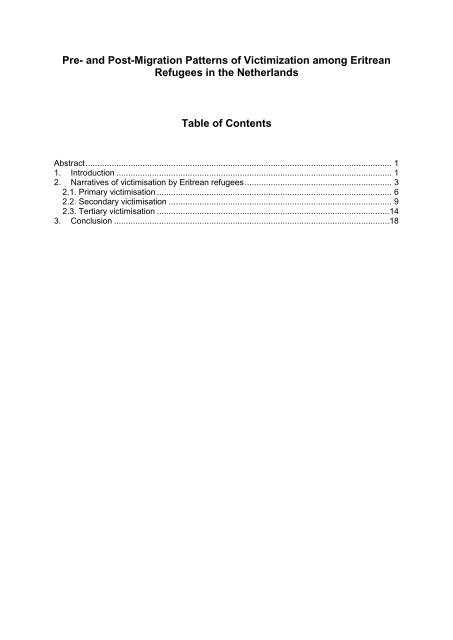
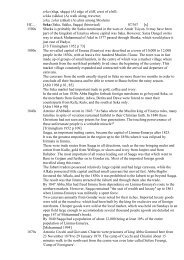
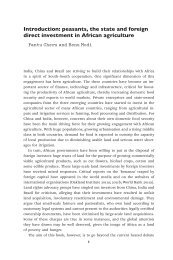
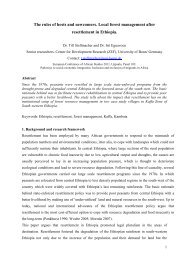
![HFE93 Kor Nebir Mikael (church) 14°25'/38°46' 14/38 [Gz] north of ...](https://img.yumpu.com/21125510/1/184x260/hfe93-kor-nebir-mikael-church-1425-3846-14-38-gz-north-of-.jpg?quality=85)
